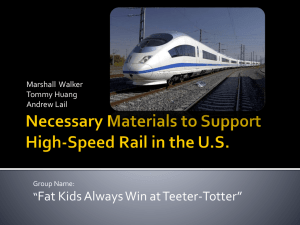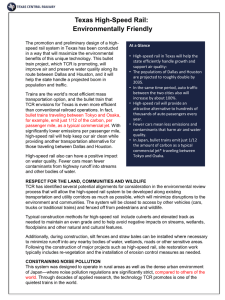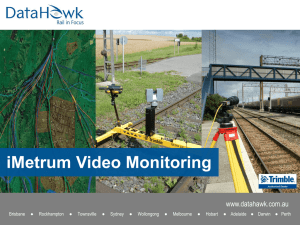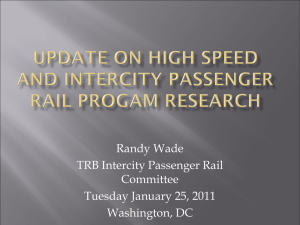Rail Capacity Workshop
advertisement
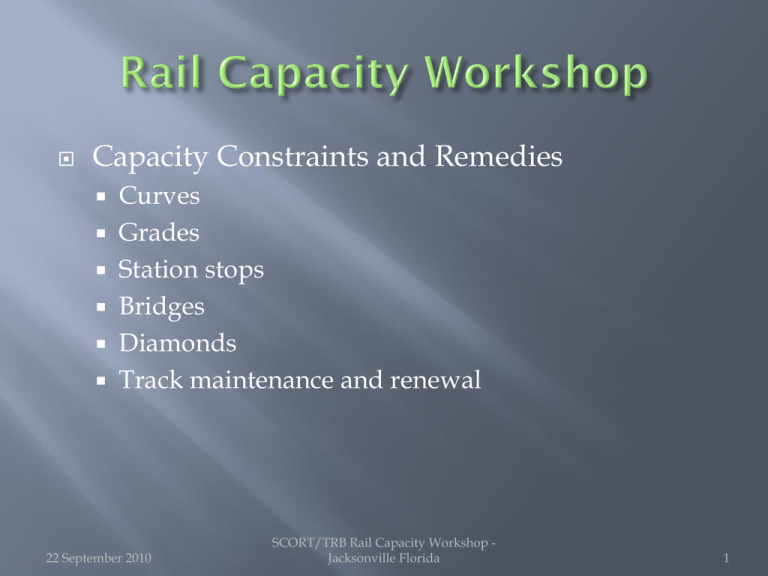
Capacity Constraints and Remedies Curves Grades Station stops Bridges Diamonds Track maintenance and renewal 22 September 2010 SCORT/TRB Rail Capacity Workshop Jacksonville Florida 1 PI 100 ft D Y T T E X M CT TC R R Circular Curve Curve of constant degree (radius) Used to change alignment direction May connect to tangents or other curves Introduced by spirals in higher-speed track Spiral Curve whose degree changes uniformly with distance from origin Used to: transition from tangent alignment to curve or between consecutive curves introduce curve superelevation Mild curvature: D ≤ 2º Medium Curvature: 2º < D ≤ 8º Sharp Curvature: 8º < D ≤ 12º Extreme Curvature: D ≥ 12º Restricted train speed Increased train resistance 0.08 lb per train ton per curve degree Affects acceleration time, power requirements Increased maintenance Track alignment and elevation Rail and wheel wear Greater potential for derailment Direction of curve R W F (a) Speed < Balanced Speed R R W F (b) Speed = Balanced Speed Relative forces on rails W F (c) Speed > Balanced Speed Vmax = maximum allowable train speed, mph Ea = outside rail elevation, inches Eu = allowable cant deficiency, inches 3 inches for conventional equipment 4 inches for certified equipment higher where approved by FRA D = degree of curve Maximum Track Speed (mph) 140 120 4½” superelevation 100 80 1 2 3 4 5 6 7 Degree of Curvature Intermodal Freight Passenger (conventional eqpt.) Passenger (tilt eqpt.) 160 60 40 20 0 8 9 10 Increase curve elevation FRA maximum for track classes 3-5 is 7 inches Generally requires spiral length adjustment Consider effect on clearances, structures, crossings Provide proper spiral design Qualify equipment for greater cant deficiency Realign track Rate of elevation change limits speed Reduce curve degree Reduce number of curves Extend sidings to reduce length of single track Reduces meet delay in speed limited territory PVI G1 G2 PVT x PVC Consists of grade tangents connected by parabolic vertical curves Grade tangent has uniform change in elevation over distance (expressed as percent) Smooth transition between grade tangents provided within length of vertical curve y L/2 L/2 L Grade force is 20 lb per train ton per percent Grades can severely affect: Maximum sustained train speed (upgrade) Acceleration (upgrade) Train speed control (downgrade) Stopping distance Train buff and draft forces Curves add resistance and limit speeds, further increasing impact of grades Impact potential of sustained grades: Low G ≤ 0.25% Moderate 0.25% < G ≤ 0.75% High 0.75% < G ≤ 1.5% Very High G> 1.5% Ruling grade: train with minimum P/W ratio can crest at crawl speed within motive power short-time limits Momentum grade: train with minimum P/W ratio will crest with some speed reduction from track speed Helper grade: train gets temporary additional power added to help crest grade Riprap territory: undulating profile requires care to control buff/draft forces in long trains Raise P/W ratio on freight trains Increase power and tonnage on freight trains May increase speeds on ascending grades Reduce need for capacity consuming helper and doubling operations Longer trains can reduce train volume, free up slots Especially useful with distributed power Avoid stopping train on severe upgrades Provide operating authority to pass restricting signals at low speed Provide power switches at sidings Change alignment to reduce grade Typically involves major capital investment May increase track length, curvature Potential complications, delays from R-O-W acquisition, permitting Tunneling, large cuts can introduce additional maintenance issues Requires careful assessment of economics Lengthening vertical curves Improves train handling Increases ride comfort at speed Provide multiple main tracks on long grades to permit passes and overtakes of slow trains Provide auxiliary tracks at top and bottom of grade to: Clear helper movements Reduce delay by trains requiring setup/release of retainers Prevent blockages while doubling Electrification Allows increase in train power, regenerative braking Major capital investment, economics sensitive to fuel prices Each stop requires time for deceleration, station dwell, and acceleration Average train speed decreases as number and spacing of stations increases Close spacing may not permit train to accelerate to track speed between stations Inefficient platform configuration may increase dwell Stopping trains may delay other traffic Through trains may have to slow at stations to reduce risk to passengers Provide train P/W ratio to achieve performance goals considering desired dwell time and station spacing Provide for meets and passes at stations where warranted by traffic demands Sidings Multiple main track Optimize platform configuration to minimize dwell time Adequate length to match access points with demand High-level fastest loading/unloading 22 September 2010 SCORT/TRB Rail Capacity Workshop Jacksonville Florida 16 Reduced train speed due to bridge design or condition Restrictions on traction/braking due to bridge design or condition Equipment restrictions due to bridge design or construction Restricted train speed approaching movable bridge Delays imposed by open movable bridges 22 September 2010 SCORT/TRB Rail Capacity Workshop Jacksonville Florida 17 Bridge condition or structural design inadequate to withstand Speed related impact loads Speed related lateral loads Reduce load effects on critical structures Remediate track condition defects Permit train crew verification of movable bridge position Reduce derailment risk at movable span Types Lift bridge Bascule (draw) bridge Swing bridge Open/close cycle time influences delay Can be significant capacity constraint with heavy water traffic More to go wrong than conventional designs Track capacity reduced by crossing movements Approaching train must be protected against conflicting movement May limit speed, increase occupancy time High maintenance location due to impact loading Problems increase with speed Flangeway Reduce maintenance requirements Provide premium components Replace with One-Way Low Speed (OWLS) design Replace with turnouts Improves reliability, operational flexibility Realignment of track costly, particularly for right-angle crossings Crossing movements still consume capacity Provide interlocking with distant signals to reduce approach delay Automatic-first come, first served Dispatcher/operator controlled-can prioritize traffic Costly, uses more real estate Permanently solves capacity issues Grade separate Railroads must inspect and maintain track Track must comply with federal Track Safety Standards (49 CFR Part 213) Track maintenance workers and machinery must be protected from train traffic in accordance with 49 CFR Part 214 The impact of these requirements on track capacity must be considered 22 September 2010 SCORT/TRB Rail Capacity Workshop Jacksonville Florida 22 Inspect track Service and adjust special trackwork and track appliances Replace or repair worn track components Replace failed track components Keep track in proper gage, alignment, and surface Maintain stormwater drainage elements Correct ballast drainage problems Address subgrade problems Control vegetation Manage thermal loads in CWR track Distribute materials for projects Repair storm or derailment damaged track Reconstruct track to higher standards Characteristics of track system Rail and rail fasteners Crossties Ballast Track horizontal and vertical alignment Effectiveness of track drainage Nature of track subgrade Traffic volume and mix Maximum train speed Maximum wheel loading Climate Owner sets train speed limits (pax, freight) Speeds establish federal track class Track condition must meet requirements for class If track condition does not meet requirements, owner must take immediate remedial action Repair Reduce track class to make defect compliant Remove track from service 22 September 2010 Track Class Max. Freight Speed (mph) Max. Passenger Speed (mph) 1 10 15 2 25 30 3 40 60 4 60 80 5 80 90 6 110 110 7 125 125 8 160 160 9 200 200 SCORT/TRB Rail Capacity Workshop Jacksonville Florida 26 Class specific Non-class specific Defect may become compliant by reducing track class (slow ordering) Examples: gage, alignment, mismatch Defect is non-compliant regardless of track class Examples: drainage, vegetation Speed defined Defect type requires specific limiting speed Example: rail defect, minimum curve elevation Working under traffic conditions Practical for many types of work Trains may pass through work site while work is in progress Typically requires speed reduction Need to clear on-track equipment adds delay Workers must have protection per Part 214 Taking track out of service Necessary for some times of work May simplify Part 214 compliance Capacity unavailable until work complete Limit duration of slow orders for defect remediation on main tracks Address root causes of maintenance problems Minimize on-track time for forces Employ hi-rail equipment where practical Provide nearby clearance location for on-track equipment Prefabricate track panels and pre-position materials Use high-production equipment and techniques Schedule work during off-peak periods Have close liaison between operations and engineering Consider need to provide for night work, lower productivity 22 September 2010 SCORT/TRB Rail Capacity Workshop Jacksonville Florida 29 Consider life-cycle costs of track components Premium components can reduce maintenance needs Include operating cost impacts of maintenance Employ “blitz” approach Plan all possible work in zone, perform during shutdown Design to reduce impacts of maintenance on operations Increase spacing between main tracks and sidings Provide crossovers in multiple track territory Consider maintenance in design of yards and terminals 22 September 2010 SCORT/TRB Rail Capacity Workshop Jacksonville Florida 30


